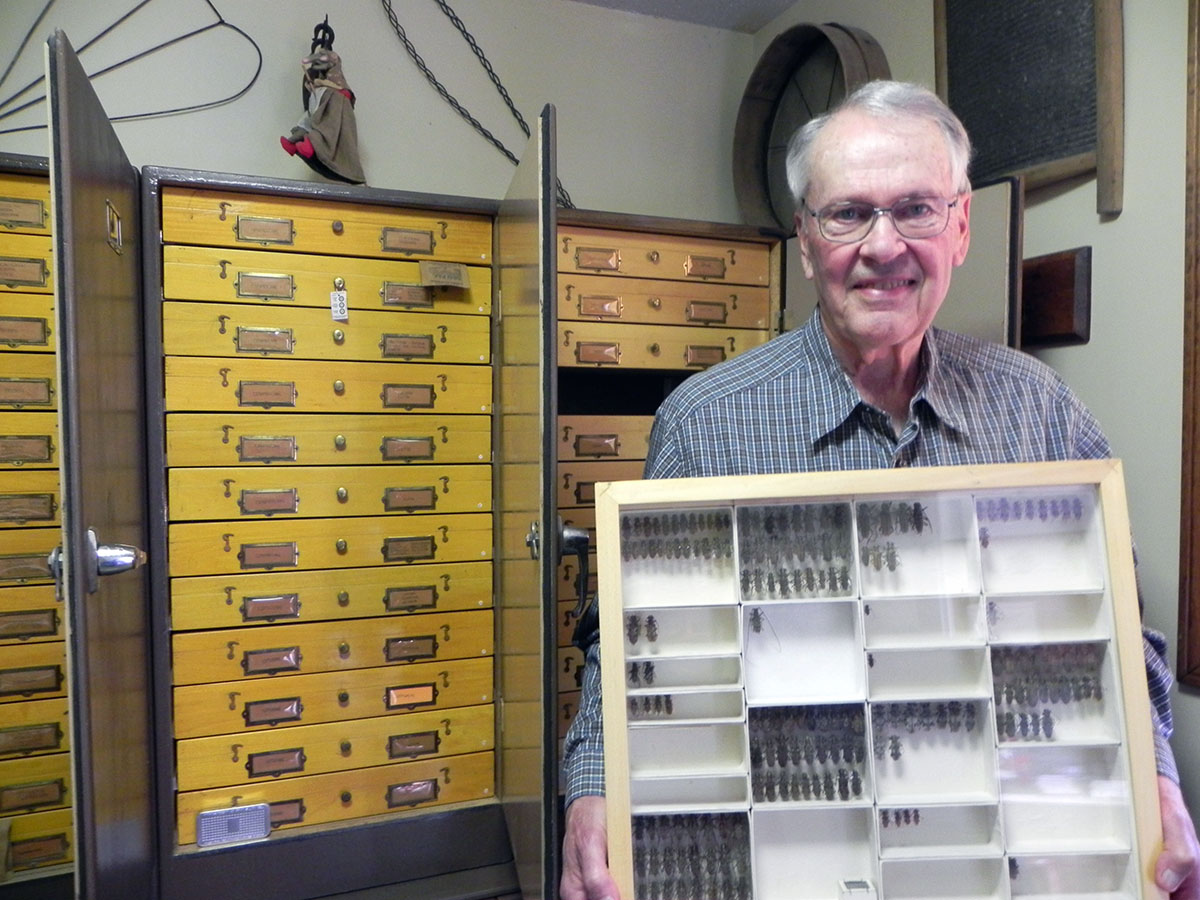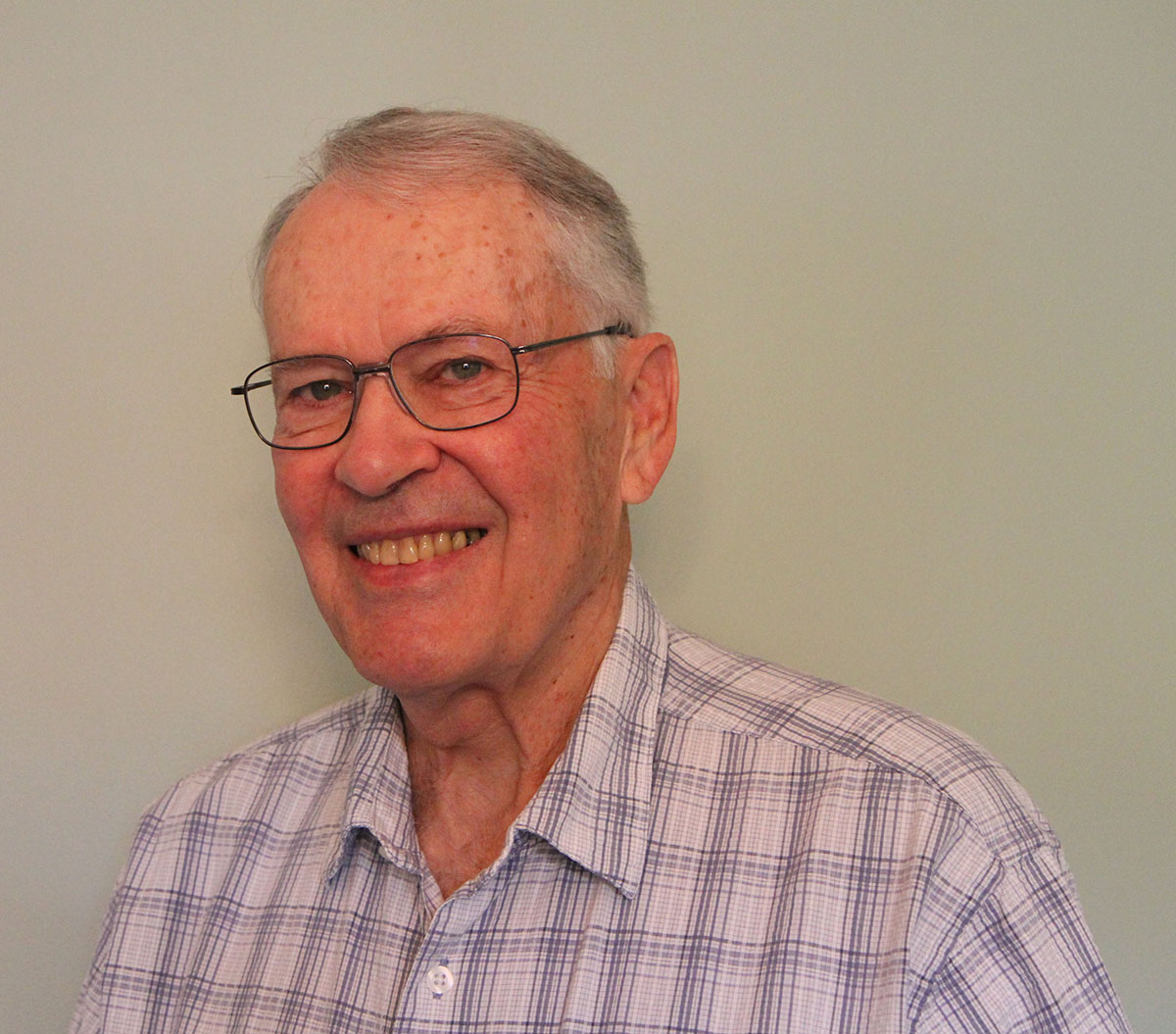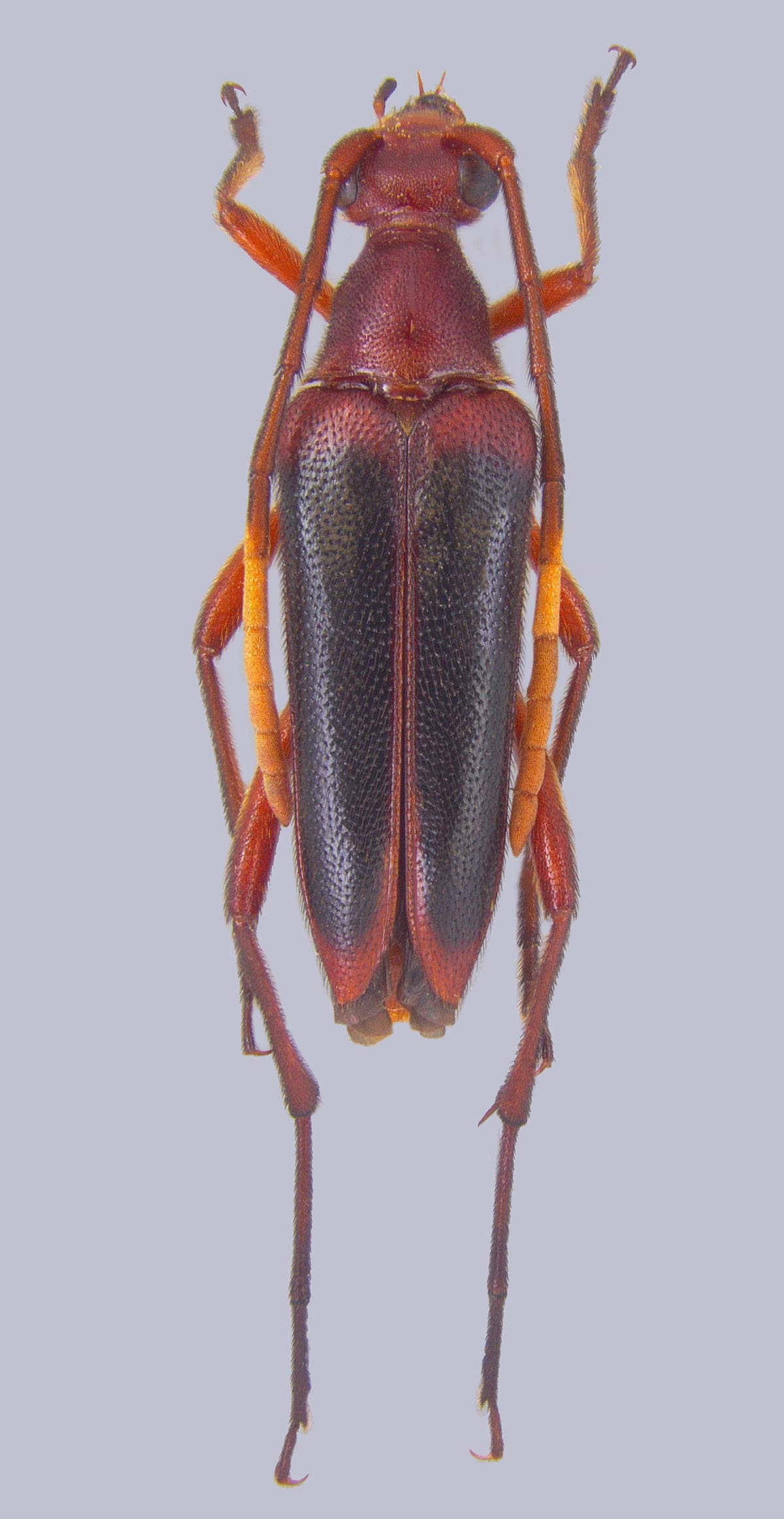The Leon Cambre Collection of Long-horned Beetles (Cerambycidae)
by Terence L. Schiefer, uploaded on 1 October 2013
A major collection of over 10,300 specimens of long-horned beetles (family Cerambycidae), representing 564 species, was recently donated to the Mississippi Entomological Museum at Mississippi State University by forestry alumnus, Leon Cambre. The collection, developed by Cambre over a period of 55 years, is especially strong in species from throughout the southeastern United States, but it also includes an excellent representation of the entire North American fauna.

Leon Cambre with his long-horned beetle collection
Cambre developed his interest in long-horned beetles while a student at Mississippi State University where he took insect taxonomy courses from Dr. E. W. Stafford. After receiving his degree in Forest Management in 1958, he began his long and distinguished career with the U. S. Forest Service. In the early years of his career, Cambre worked as a Forester and Assistant District Ranger in Mississippi and then as a Forest Entomologist for eight southeastern states. Later, he served as District Ranger for Ouachita National Forest in Arkansas, Deputy Forest Supervisor for Daniel Boone National Forest in Kentucky, Forest Supervisor for all six National Forests in Mississippi, and Forest Supervisor for Mark Twain National Forest in Missouri, collectively administering over 3.5 million acres for natural resource management during the course of his career. He also worked in Washington D.C. under a Congressional Fellowship and then served as Director of Legislative Affairs and Director of Cooperative Forestry for the U. S. Forest Service.
Leon Cambre's career path necessitated frequent moves by his family, allowing them to experience living in many interesting places across the southeastern United States. Living in or near National Forests provided a life full of adventure for Leon, his wife, Elizabeth, and their children. The frequent moves and other job related travels gave Leon ample opportunity to collect long-horned beetles from a wide variety of locations in most of the southeastern states, which he did so avidly. Many of his specimens were collected in light traps or on flowers. Others were collected on or reared from host plants. Collecting long-horned beetles was often a family affair, with Elizabeth and the children assisting in capturing the beetles. Even Leon's mother collected long-horned beetles for him in a light trap at her home along the Pearl River near Jackson, Mississippi.
When Leon began his studies, species identification of long-horned beetles was much more difficult than it is today. There was no comprehensive work covering the entire North American fauna, and accurate identification often required access to original descriptions scattered in publications that were difficult to obtain. To facilitate his studies, Leon gathered much of the necessary literature and established communications with many of the taxonomists and collectors who were studying long-horned beetles at the time including John Chemsak, Josef Knull, Bill Tyson, Frank Hovore, Dick Penrose, Jim Cope, and many others. In order to increase the diversity of species in his collection, Leon exchanged specimens with many of these individuals, obtaining species from western and northern North America for specimens from the southeastern United States. Over the years, Leon has also contributed many specimens to various Forest Service regional research collections and to a number of university collections in the southeastern United States.
One of Leon's important contributions to the study of long-horned beetles was his discovery of a species new to science. In 1959, while working in Bienville National Forest near Forest, Mississippi, Leon collected an unfamiliar long-horned beetle on the flowers of Black-eyed Susan. In the following years, he collected additional specimens throughout Bienville National Forest and other nearby areas, always on the flowers of Black-eyed Susan. The specimens did not fit the description of any known species of long-horned beetle, and Leon, suspecting that they were a species new to science, sent them to long-horned beetle taxonomists, Gorton Linsley and John Chemsak at the University of California. They agreed that it was a new species and described it in their monograph on North American long-horned beetles, naming the species Strangalia cambrei in honor of its discoverer, Leon Cambre. To date, the species is only known from Mississippi.
Leon Cambre -- a chronology
31 October 1932 – Leon Cambre was born in Jackson, Mississippi.
1950 – Graduated from Central High School in Jackson, Mississippi.
1950-1951, 1955 – Attended Hinds Jr. College, Raymond, Mississippi.
1951-1955 – Served as Staff Sergeant in the U. S. Air Force and is a Korean War veteran.
1955 – Married Elizabeth Phillips of Flora, Mississippi. They had five children: John, Mary, Susie, Cheryl, and Joe. Three of their children have Mississippi State University connections: John is retired from MSU, Mary is an MSU graduate in horticulture, and Susie is an MSU graduate in chemical engineering.
1955-1958 – Attended Mississippi State University on the GI Bill. Took insect taxonomy courses under Dr. E. W. Stafford. Graduated in 1958 with degree in Forest Management.
1958-1960 – Forest, Mississippi. Forester for Beinville National Forest.
1960-1961 – Rolling Fork, Mississippi. Assistant District Ranger for Delta National Forest.
1961-1963 – Pineville, Louisiana. Forest Entomologist for Louisiana, Texas, Oklahoma, Arkansas, and Mississippi.
1963-1965 – Macon, Georgia. Forest Entomologist for Georgia, Alabama, and Florida.
1965-1969 – Oden, Arkansas. District Ranger for Ouachita National Forest. Administered 181,000 acres for natural resource management.
1969-1971 – Winchester, Kentucky. Deputy Forest Supervisor for Daniel Boone National Forest. Administered 750,000 acres for natural resource management.
1971-1972 – Washington D.C. Congressional Fellowship. Worked for Senator Lee Metcalf of Montana as his principal aid in Natural Resources and Congressman John Henry Kyl of Iowa on the House Interior and Agriculture Committees.
1972-1975 – Jackson, Mississippi. Forest Supervisor for all six National Forests in Mississippi. Administered 1,136,000 acres for natural resource management.
1975-1977 – Washington D.C. Director of Legislative Affairs for the U. S. Forest Service. Coordinated and administered Forest Service Legislative Affairs activities.
1977-1979 – Washington D.C. Director of Cooperative Forestry for the U. S. Forest Service. Directed cooperative programs between the Forest Service and other Federal, State, and private groups from throughout the United States.
1979-1986 – Rolla, Missouri. Forest Supervisor for Mark Twain National Forest. Administered 1,500,000 acres for natural resource management.
1986 to present – Retired in Rolla, Missouri. Manages his 300 acre tree farm mainly for wildlife. Serves on the Board of Trustees for the L-A-D Foundation, which is dedicated to sustainable forest management and protection of exemplary natural and cultural areas in Missouri including Pioneer Forest.
Leon Cambre - Awards and Honors
- Governor's Conservationist of the Year Award for Mississippi (1974) from the Mississippi Wildlife Federation.
- Governor's Conservationist of the Year Award for Missouri (1986) from the Conservation Federation of Missouri.
- Secretary of Agriculture's Superior Service Award for “outstanding effective management of Mark Twain National Forest.”
- Federal Energy Efficiency Award (1982) from U.S. Secretary of Energy for “exceptional accomplishments in energy efficiency in the Federal Sector.”
- Resource Steward Award (1985) for state of Missouri from Missouri Department of Natural Resources.
- Special Recognition from President Ronald Reagan (1986) for “bringing about significant savings in federal management.”
- Outstanding Alumnus Award (1980) from School of Forest Resources, Mississippi State University.
- In “Who’s Who in the Midwest, 1986-1987.”
- Society of American Foresters Fellow and Golden Member.
- Wildlife Society Life Member.




